
The “desk protector” from my first job in 1976. I was a bit obsessed about type.
In 1976, I dropped out of college to take a job at a small advertising art studio in Minneapolis. I was there only five months. I quit to take another job, this time as production manager and designer at Metropolis, a weekly newspaper in Minneapolis. Until it went out of business nine months later. My third job was another small advertising art studio started by two people who had left the place where I’d worked my first job.
Thanks to a project I did in college, I’d become hooked on the idea of designing typefaces. In idle moments at these jobs, you would often find me sketching and doodling ideas for typefaces. They were mostly not very good, but the more I did it, the better they got.
In 2016–2017, I scanned and catalogued all the type idea sketches I’ve made (and saved) over four decades. Most of the early stuff was not great, but a few ideas were promising. One was a very minimal idea from about 1978, drawn in felt pen on a sheet of layout paper, where I (incorrectly) spelled out the word “Tarifs.” (I ran out of space, plus, why draw the same letter twice?)

My sketch from 1978.
I don’t recall exactly what I was thinking when I drew it. I was probably bored, avoiding whatever it was I was supposed to be working on. When I’m doodling letters, I don’t usually have any conscious plan. Things just spill out from my brain, which collects things I’ve seen like a magpie in my subconscious. Looking at it now, it most likely came from the kind of slick lettering you would see on book covers in the seventies. I often spent my lunch breaks hanging out in bookstores, so, it could be. I think there are bits of Times New Roman and Arrow there, too.

My draft of caps and lowercase from 2017, interpreting my nearly 40-year-old sketch.
I did a draft of it in 2017, extrapolating from these six letters. Of the roughly 30 “backburner” ideas I did drafts of back then, this “Tarifs” idea got a lot of positive reactions when I showed it to people.
In February this year, I decided to do it for real. This meant expanding the range of weights and then expanding the character set (the draft was just the basic alphabet in caps and lowercase).

Expanded range of weights from the Semibold starting point.
As I did this, the design became more disciplined than my original sketch. I dropped the cupped serifs (a case of naive excess), but tried to preserve the basic idea, with its sharp, deeply bracketed serifs and graceful curves.

The 1978 sketch vs. the final design.
Unlike similar faces like Times or Arrow, it features head serifs that are flat rather than angled, and generally mirror the construction of the capitals as much as possible, avoiding things like ball terminals.

Initial figures concept and final.
When it came to the figures, my first inclination was to give them an angled stress (just because I like that style), but I quickly realized they needed to have the same vertical stress as the caps and lowercase.
The original concept didn’t include an italic, but I didn’t like the idea of releasing it without one. By April, I was already working on one. Leaving out elements like ball terminals made the design of the italic more challenging, but I think my solution works well.

The matching italics.
One of the trickier parts was coming up with a name. It was never going to be “Tarifs” (the working name, after the original sketch). After trying out a few different ideas, I settled on Hardcover, which is a nod to my likely inspiration back in 1978. It also indicates how this face is intended to be used: Large, like on the cover of a 1970s bestseller. (It does also work for text, but I wouldn’t set a book in it.)

Hardcover comes in seven weights, from Extralight to Black, in both roman and italic. All styles include small caps, tabular and proportional figures in both lining and old style, support for Western and Eastern European languages, and a set of matching dingbats.

Hardcover is available now. More information here.
It was twenty years ago today that I released the first version of Proxima Nova. I’d spent the previous two and a half years working on it as a redesign of Proxima Sans, which I released through FontHaus in 1994.
For whatever reason, Proxima Sans never really became very popular. Part of it no doubt was that it was a small family of only three weights: Regular, Medium, and Black, plus italic for each. The character set was minimal, basically covering the default Mac and Windows, with a few rarely-used math characters replaced by dingbats and extra characters. This was before OpenType and Unicode were standard and there were a lot of questionable practices.
Sales of licenses were not great. It didn’t help that Proxima Sans was added to the FontHaus catalog before the font was available for purchase (my fault). I didn’t finish it until months later. I saw it used here and there, but it seems like a dud.
In 2002, two things happened.
First, Hoefler & Frere-Jones released Gotham to the general public. Previously, it was exclusive to GQ magazine, in use since 2000. I wasn’t a GQ reader, so this was the first I had become aware of it. It was very well designed, but weirdly similar to Proxima Sans, and getting a lot of attention in the design community.

The first issue of Rolling Stone featuring Proxima Sans, from September 2002, seen in the small text on the cover.
Second, late in 2002, magazine designer Matthew Ball did a redesign of Rolling Stone and used Proxima Sans extensively for headlines, captions, subheads and small text, along side Frederic Goudy’s Kennerly for running text. This was the most prominent use of Proxima Sans.
I learned later in a conversation with Jonathan Hoefler that this was the first time they’d ever seen Proxima Sans, thinking it was Gotham at first and wondering how they were using it without a license.
These two things convinced me that there was indeed a market for something like Proxima Sans, and that I should take advantage of this to expand its range of weights and styles, and to take advantage of the OpenType format by adding better language support and other typographic niceties, like small caps and alternate characters.
In doing the redesign, I did more than add to what I’d done before in Proxima Sans. I redrew nearly all the characters and changed the weighting scheme, making the Regular a little lighter and pushing the range of weights further. I realized very quickly that it wouldn’t be backward-compatible with Proxima Sans at all, so I came up with a new name—Proxima Nova, taking a cue from Century Nova, the final addition to ATF’s Century family in 1964, and one of the last foundry typefaces to be released.
Flash animation announcing Proxima Nova from my site in 2005.
After two and a half years of intensive work, and the help of a small group of beta testers (including Stephen Coles, Tim Martens, and Dirk Benedict), I released Proxima Nova on June 30, 2005, initially through direct sales through my own website (with a discount if you were a Proxima Sans user), and followed by Veer (January 2006), FontShop (February 2006), and MyFonts (July 2007).
The first license was purchased by Addison Hall on July 1, 2005. It was a strong seller from the start compared to the other fonts I was selling at the time, and its popularity steadily grew. I also got an early boost from a little pamphlet that was produced by Yves Peters and distributed at TypeCon 2005 in New York City which included Proxima Nova in his reviews of favorite new typeface releases of 2005.

The original Typekit logo, pre-Adobe.
What really sent it to the top of the charts was Typekit in 2009. This was initially an independent startup, founded by Jeff Veen. Web designer Jason Santa Maria who was working with Typekit in the early days invited me to participate. It started out slowly and then shot up to become the most popular way to use custom webfonts. By the time Typekit was acquired by Adobe, Proxima Nova had become the most popular commercial font on the web. It’s still at the top.
Its popularity extended beyond the web—probably because of its popularity there. Here are some of my favorite examples:

Proxima Nova has grown well beyond my initial release, with a greatly expanded character set (including support for Greek and Cyrillic and, more recently, Arabic, Hebrew, Thai, Hangeul, Tamil, and Devanagari, thanks to my relationship with The Type Founders). From a family of 42 fonts (seven weights, three widths, plus italics), it’s grown to 80 (eight weights, five widths, plus italics).
The growth and popularity of Proxima Nova in the last twenty years is beyond my wildest, most optimistic expectations when I released it in 2005, much less when I released Proxima Sans in 1994. It’s the dream of every type designer but almost never happens. I feel incredibly lucky and grateful to everyone who has helped along the way, and especially to all the designers who decided that it was the best font for the job.
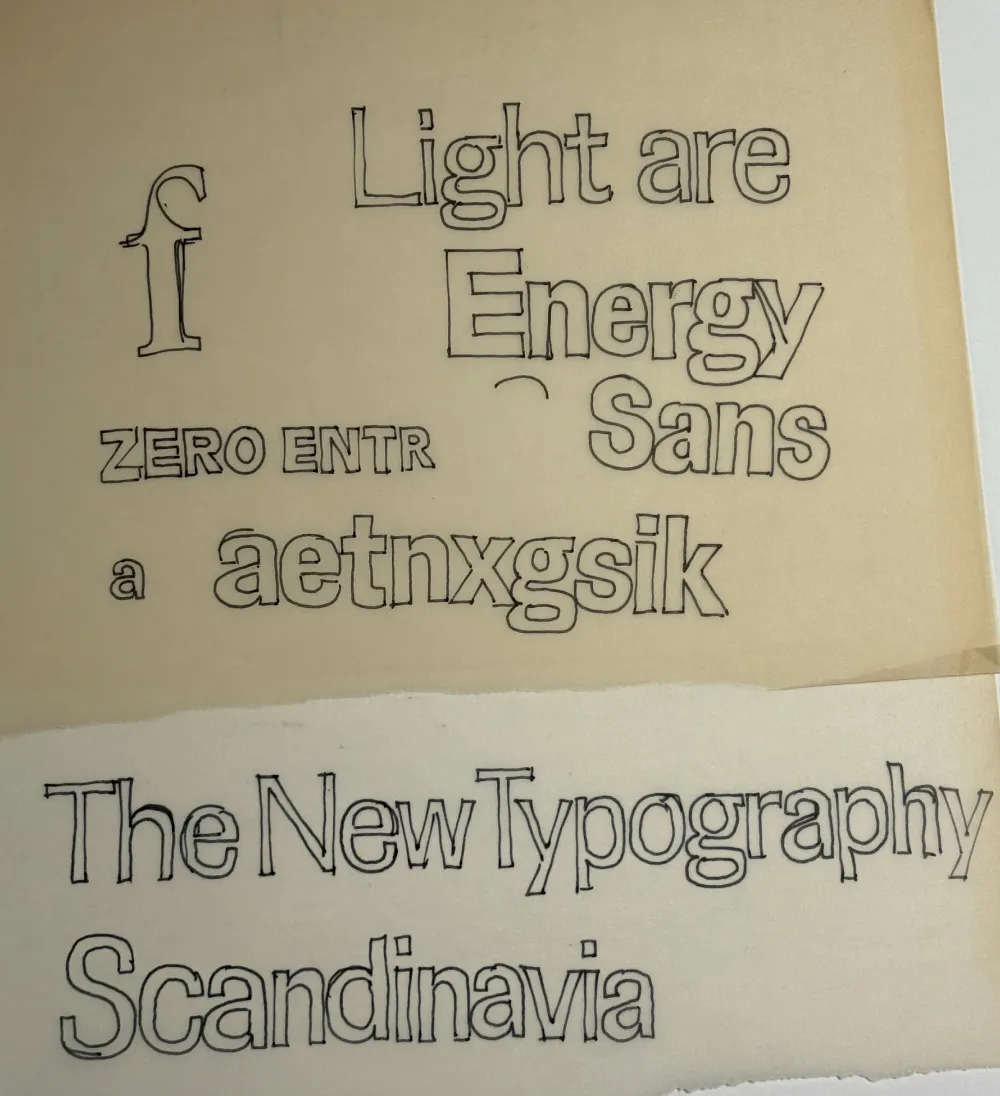
Sketch from about 1981.
Synergy started as an idea I had about 1981. I found a couple of sketches in my collection of typeface ideas going back to the seventies, which I started scanning and organizing in 2009. I don’t remember a lot about this particular idea except that I was aiming for a “Scandinavian” feel (whatever that meant to me at the time) and that the 1970s Allstate logo was an influence.

Early drafts.
I thought it was a promising idea and did a draft of the lowercase in a couple of weights in 2012, then another draft in 2018, which included capitals and a full range of weights from very thin to very bold, using three “masters.” (Masters are used in modern type design to generate intermediate weights automatically from a small set of key drawings.)

Weights and styles of Synergy.
Then, in 2024, I decided to complete the design, adding a set of italics for all weights and features such as small caps and old style figures.
Synergy is basically a neo-grotesque along the lines of Swiss faces such as Univers, but with a two-story “g” more characteristic of British and American models. This wasn’t a deliberate decision, but I think the constraints I gave myself—even somewhat narrow proportions, squarish curves, squared-off stroke endings—steered me in that direction. I think I succeeded in giving it more warmth than this type of design usually has, thanks to some subtle details in the curve endings, and the two-story “g” relieves the monotony in text.

The two-story “g” and subtle details in the curved stroke endings are reminiscent of British grotesques.
I was careful to make sure Synergy works well in text in the middle range of the weights. It also works for display use, and the extreme weights (Hairline, Thin, and Ultra) are intended exclusively for that.

A text sample.
Synergy has nine weights. If that’s not enough, there is also a variable version. It features small caps (with matching punctuation) and old style figures in all styles. It has support for most Latin-based languages and currencies, arbitrary fractions, and a set of matching dingbats.

A small sampling of the character set.
Synergy is available now. More information here.
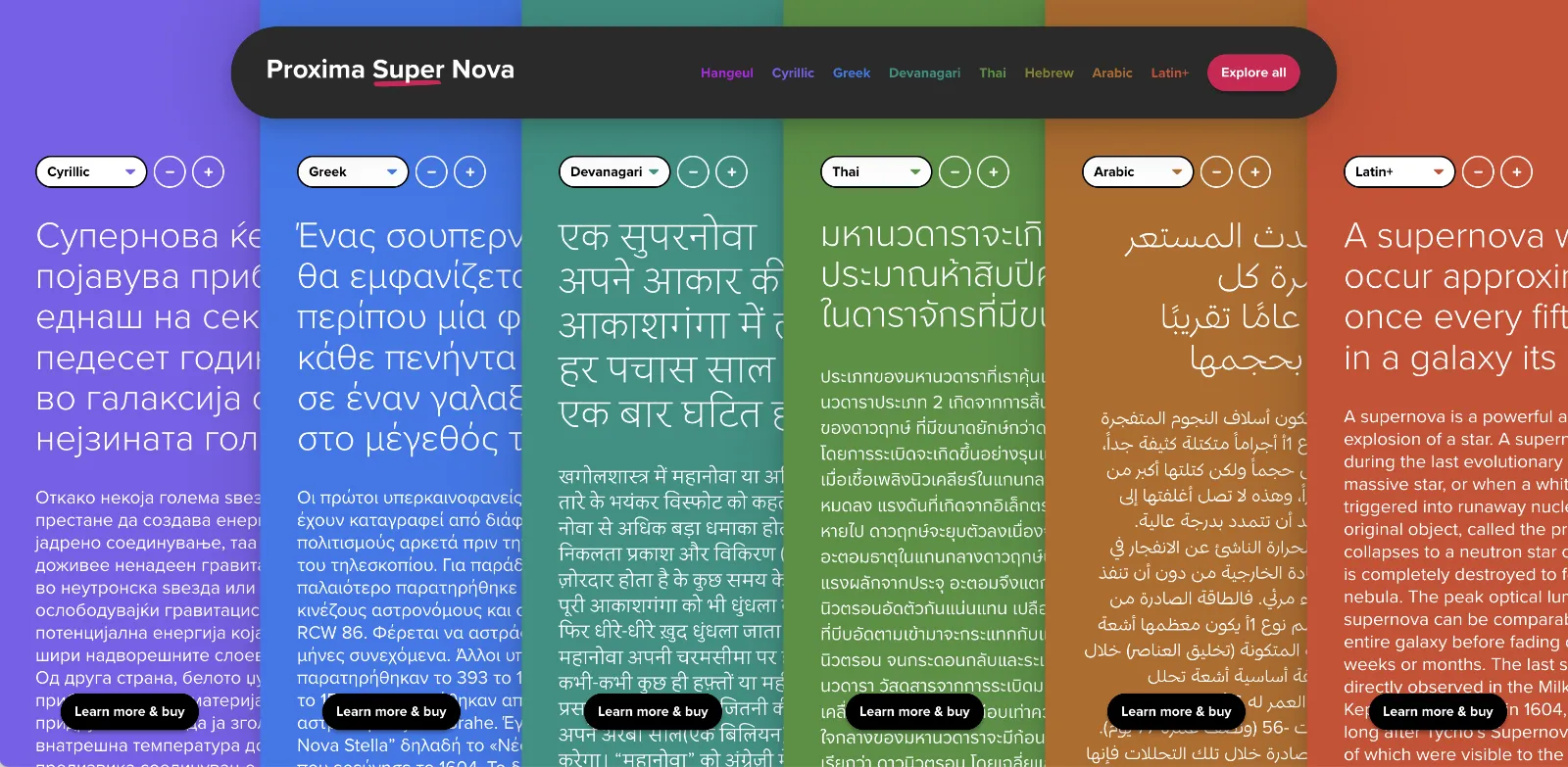
When I decided to sell the rights to my library of fonts to The Type Founders in 2021, one of the big reasons for me was the ever-growing burden of maintaining and developing that library.
As a one-person studio, there was only so much I could do. Proxima Nova had become very popular since I released it in 2005, and I regularly got requests to expand its language coverage.
At first, I did this task myself, adding support for Greek and Vietnamese in 2009 and Cyrillic in 2010. Even though I can’t read languages that use these writing systems, they were close enough to the Latin alphabet that I felt sufficiently confident to design them. But I’ve always felt out of my depth as a type designer even thinking about designing non-Latin fonts.
Still, I could see that adding even more language support would make a lot of sense for such a popular type family. Theoretically, I could hire other designers and production people to help, either as employees or as contractors. But that would mean managing those people, something I know I’m not very good at.
I like working by myself, and I would rather spend my time working on new typefaces.
It was around the time I was thinking about these problems back in 2019 that I was approached by Paley Dreier (now Managing Partner of The Type Founders) about selling my font library. It was something I’d never thought about before, but I eventually realized that it would be a neat solution to my problems. I would be relieved of the burden of maintaining and expanding my existing fonts, giving me time to focus on designing and releasing new fonts—which is what I’ve been doing for the last few years, with the release of Proxima Sera, Dreamboat, Proxima Nova Wide and Extra Wide, Viroqua, Cheesecake, Madcap, Gertie, and Skin & Bones. In fact, I’m currently working on a new sans serif family, the first since Proxima Nova, if you don’t count display faces.
In the meantime, The Type Founders has been working to expand language support for Proxima Nova, with the aid of some really talented type designers from around the world. We’ve dubbed the fruits of this effort Proxima Super Nova.
In addition to most Western and Eastern European Latin, Greek, Vietnamese, and Cyrillic, Proxima Nova now supports Arabic, Devanagari, and Thai (both looped and loopless). More writing systems are in the works, including Hebrew and Hangeul.
Check out the Proxima Super Nova mini-site to find out all about it.
If you have any questions, are interested in extended or enterprise licensing, or need additional language support or customizations, get in touch! Send a note to info@marksimonson.com
A big thanks to the following people:
Proxima Nova Thai: Smich Smanloh of Cadson Demak
Proxima Nova Devanagari: Vaibhav Singh and Alessia Mazzarella of Typeland
Proxima Nova Arabic: Khajag Apelian and Wael Morcos
The mini-site: Elliot Jay Stocks (site design and content development) and Roel Nieskens (site development)
Project management and production support: Glenda Bellarosa and Dyana Weissman
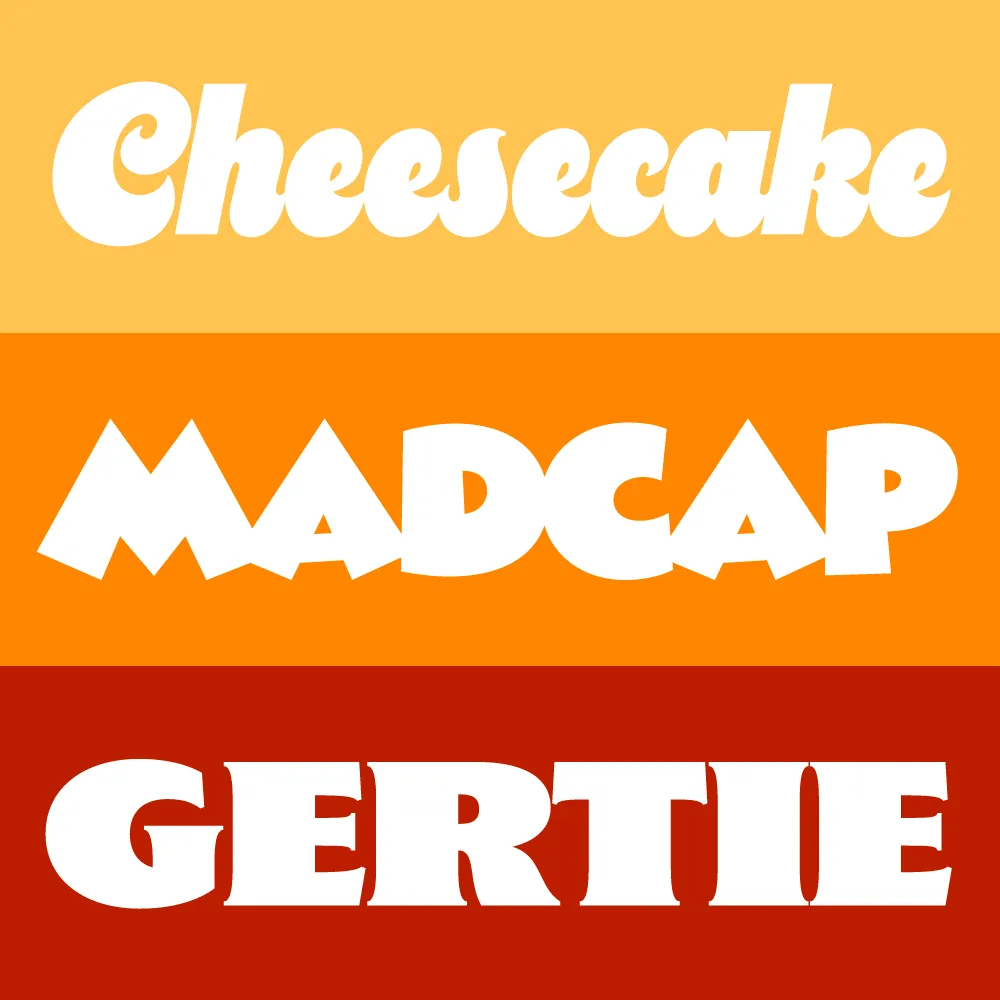
I took a break from my usual practice of working on larger families to create a trio of heavyweight display typefaces: Cheesecake, Madcap, and Gertie. They come from different historical periods—and different periods in my life.

Cheesecake is the most recent design. It bubbled up from my subconscious over the last ten years while I was working on Dreamboat. Like Dreamboat, it’s a “bold script” style, but it has more in common with 1970s lettering and fonts, and is a simpler design without any need for fancy OpenType magic in order to set properly.

I tried to push the weight as far as I could without sacrificing legibility. It has an alternate lowercase “s” (in case you’re not into that old-school cursive form) and a set of matching dingbats and symbols.
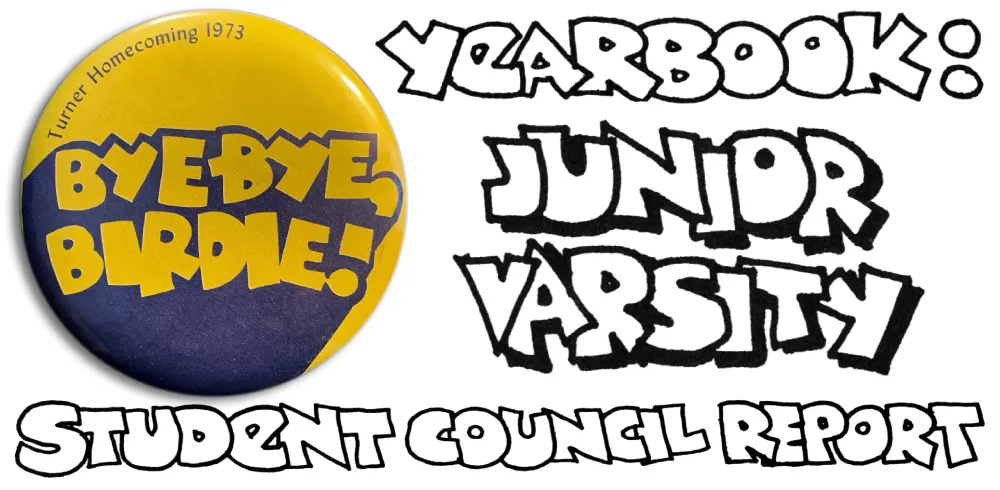
Madcap goes back to my high school years in the early seventies, before I was even thinking about type design. I worked on student publications and often did lettering in a cartoony, all-caps style, with overlapping letters. I was influenced by vintage MAD magazine and Hallmark and American Greetings’ psychedelic period.

Madcap has a few special features: An alternate lowercase-style E and a set of matching dingbats and symbols.
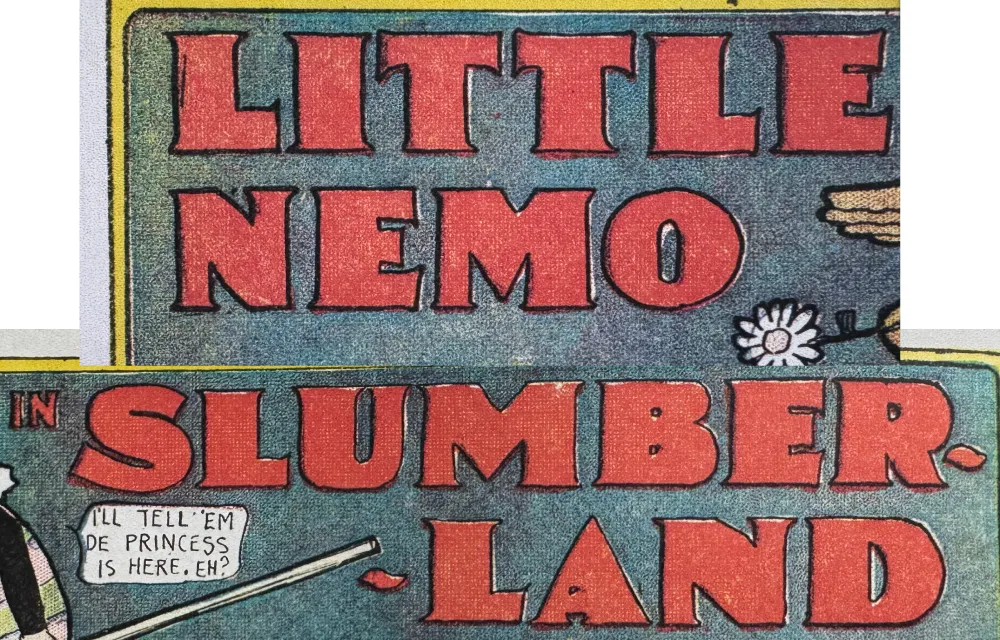
Gertie is a design that’s been in the back of my mind since the late nineties. The inspiration is Winsor McCay’s distinctive lettering in his iconic Little Nemo comic strips from the early twentieth century. Think of it as Copperplate Gothic on steroids. The name comes from McCay’s 1914 animated short Gertie the Dinosaur—the first fully-realized animated cartoon character.

As an all-caps design, it can be awkward to set words and abbreviations that normally contain lowercase like “McCAY” or “4th” or “Co.” So I’ve included a set of raised caps for those situations. And it works with more than one letter in a row. You can also use it for the cents part of prices. Like Cheesecake and Madcap, it includes a set of matching dingbats and symbols.
All three fonts are available now.
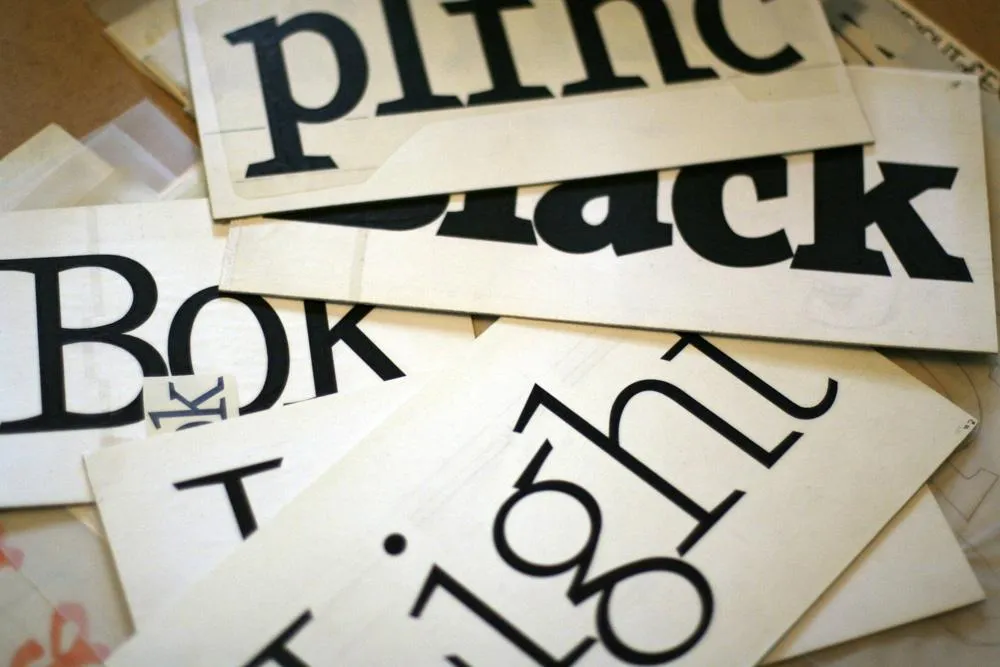
Viroqua’s ancestor, Excalibur, hand inked.
I released Kandal in 1994. It’s one of my earliest typeface designs, going all the way back to an earlier design in 1978, which I submitted it to International Typeface Corporation (ITC) under the name “Excalibur”. It went through a couple of iterations before the one I submitted, variously influenced by the work of Hermann Zapf and Jim Parkinson. I honestly had very little idea what I was doing—a case of overestimating what I knew and underestimating how much was left to know. By a large margin. Excalibur was understandably rejected by ITC. It had lots of problems and I resolved to improve my knowledge and skills before trying to submit something to them again.

Fast-forward to 1990. I never did submit any more typefaces to ITC, but I did have lots of ideas and sketches and practice drawing letters. I also got a Mac in 1984 and Fontographer in 1987 and started trying to make PostScript fonts. One of my ideas was to revisit Excalibur, simplifying the design and addressing its many flaws. This became Kandal. I was also working on Proxima Sans, the predecessor to Proxima Nova, around the same time, and a few other ideas, some of which are still on the drawing board.
Kandal has never been one of my popular typefaces. It’s not surprising, given that it was such an early design, made when I had very little experience making fonts. I probably should have pulled it from my library, but I kept thinking I would come back to it and fix it, like I did with Proxima Sans.
Thirty years later, it’s finally happened. The new version is reworked from the ground up, so I decided to give it a completely different name, instead of something like Kandal Nova. “Kandal” was my paternal grandmother’s maiden name and the town in Norway her family was from. The new name, “Viroqua”, is the town in Southwestern Wisconsin where she was born and raised.

Viroqua is an improvement over Kandal in every way I could think of, while retaining its core design concept: A hybrid combining modern proportions, Jenson-like details, and a bit of slab serif DNA. Nearly every character has been reworked or refined. The original italic especially suffered from my lack of experience as a type designer. I basically started over. I’ve got three more decades of experience and I hope it shows.

Viroqua also has a wider range of weights, seven in all, going from Thin to Black.

Viroqua features many typographical niceties missing from Kandal, such as small caps, old style and lining figures (both proportional and tabular), superscript and subscript figures, fractions, and dingbats. Viroqua also supports most Latin-based Western and Eastern European languages, plus Vietnamese.
Viroqua is available now. More information here.
